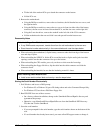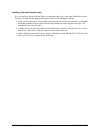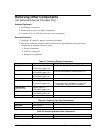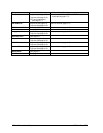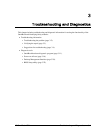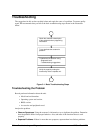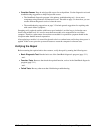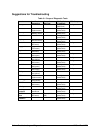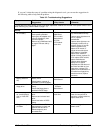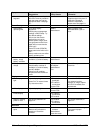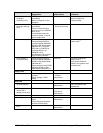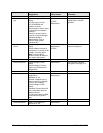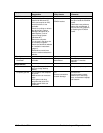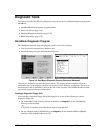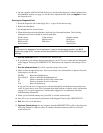
HP OmniBook XE2 Troubleshooting and Diagnostics 3-5
If you can’t isolate the cause of a problem using the diagnostic tools, you can use the suggestions in
the following table to help find the problem.
Table 3-2. Troubleshooting Suggestions
Symptom Call Center:
Suggestions
Repair Center:
Likely Causes
Repair Center:
Comments
To help determine likely causes, check to see what replaceable modules are involved in the system function and
what roles they play. See the table on page 1-13.
Startup
Does not boot on
AC or battery
Check the power source.
Push system-off button.
Unplug the AC adapter and
remove all batteries, then
reconnect power.
Remove any RAM board and
try again. Reinsert and try
again.
AC adapter.
RAM board.
CPU module.
Motherboard.
I/O PCA.
LCD module.
Hard drive.
Check AC adapter. Remove
any RAM boards and retry.
If power status light does not
turn on, replace
motherboard.
If power status light turns on
but display remains off, try
external monitor. If monitor
shows successful boot,
replace LCD module. If
monitor shows activity but
BIOS does not complete,
replace CPU module. If
monitor is blank, replace I/O
PCA, replace CPU module,
replace motherboard.
If power status light and
display turn on, BIOS
completes, but OS does not
start from hard disk or from
floppy drive, replace CPU
module, then motherboard. If
OS starts from floppy drive,
reload hard drive, replace
hard drive.
Does not boot on
battery (boots on
AC)
Check battery level on
battery LEDs.
Check battery contacts. If
available, try another battery.
Battery.
Motherboard.
Does not boot from
floppy drive
Check boot order in BIOS
Setup.
Check that floppy boot is
enabled in BIOS Setup.
Floppy drive or
contacts.
Motherboard.
Error message such
as “Invalid system
disk” or “Auto IDE
error”
Check for a disk in floppy
drive.
Remove and reinsert hard
drive.
Check boot order in BIOS
Setup.
Hard drive contacts.
Hard drive.
If unit boots from floppy drive,
check for corrupt files on
hard drive, reload hard drive,
replace hard drive.
Sluggish startup or
shutdown
Run ScanDisk and Disk
Defragmenter to check and
optimize the hard drive.
Delete temporary and
unneeded files.
Use same suggestions
shown at left.



